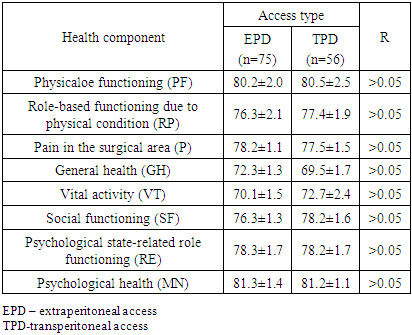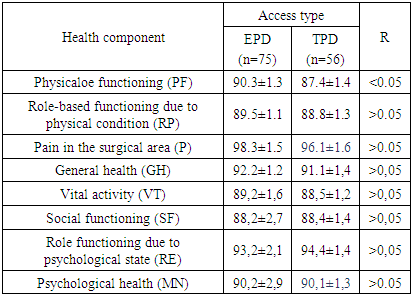-
Paper Information
- Next Paper
- Previous Paper
- Paper Submission
-
Journal Information
- About This Journal
- Editorial Board
- Current Issue
- Archive
- Author Guidelines
- Contact Us
American Journal of Medicine and Medical Sciences
p-ISSN: 2165-901X e-ISSN: 2165-9036
2024; 14(11): 2827-2829
doi:10.5923/j.ajmms.20241411.32
Received: Oct. 23, 2024; Accepted: Nov. 10, 2024; Published: Nov. 13, 2024

Comparative Assessment of Quality of Life after Radical Cystectomy Depending on the Type of Access Using the SF-36 Questionnaire
M. I. Boltaev1, M. N. Tillyashayhov2, E. V. Boyko2, D. F. Ibodova3
1Bukhara Branch of the Republican Specialized Scientific and Practical Medical Center of Oncology and Radiology, Uzbekistan
2Republican Specialized Scientific and Practical Medical Center of Oncology and Radiology, Uzbekistan
3Tashket Medical Academy, Uzbekistan
Copyright © 2024 The Author(s). Published by Scientific & Academic Publishing.
This work is licensed under the Creative Commons Attribution International License (CC BY).
http://creativecommons.org/licenses/by/4.0/

Objective: to determine differences in the quality of life of patients after radical cystectomy depending on the type of access using the SF-36 questionnaire. Material and methods: 131 patients with invasive bladder cancer (T2-3 N0-2 M0) were examined. All patients underwent radical cystectomy with dissection of the pelvic lymph nodes, of which 75 patients (63.2±4.3 years) underwent extraperitoneal surgery, and 56 patients (61.1±5.6 years) underwent transperitoneal access. Observation monitoring was carried out upon discharge of the patient from the hospital, 3 and 12 months after surgery. The SF-36 questionnaire was used to assess the quality of life of patients. Results: during the entire observation period, the average scores for almost all indicators of the questionnaire, except for the indicator of physical functioning, at the end of 3 months of observation, did not have a significant difference. Conclusion: according to the SF-36 questionnaire, the quality of life of patients after radical cystectomy does not depend on the type of access.
Keywords: Bladder cancer, Radical cystectomy, Quality of life of patients
Cite this paper: M. I. Boltaev, M. N. Tillyashayhov, E. V. Boyko, D. F. Ibodova, Comparative Assessment of Quality of Life after Radical Cystectomy Depending on the Type of Access Using the SF-36 Questionnaire, American Journal of Medicine and Medical Sciences, Vol. 14 No. 11, 2024, pp. 2827-2829. doi: 10.5923/j.ajmms.20241411.32.
1. Introduction
- The term "quality of life" has become widespread in recent decades. This is an interdisciplinary concept, the sphere of interests of researchers representing various humanities and natural sciences. Since the 70s of the last century, the perceived quality of life has become one of the key areas of sociological research. This problem comes to the fore in oncology, where the question of the patient's right to choose therapy and the preference of medical interventions leading primarily to improving the quality of life of patients is discussed [1].Quality of life is determined by the patient's own assessment of the degree of satisfaction with various aspects of their life due to real or expected changes caused by the disease and its consequences, as well as related to the process of medical supervision and treatment [2]. The key components of these assessments are quality of life and symptoms. With the help of patient ratings, you can analyze the patient's problems and expand the amount of information about the effectiveness of treatment. Information about the quality of lifebased on the patient's own opinion is extremely useful, both in scientific research and in real clinical practice, when choosing the optimal patient management tactics, when evaluating the effectiveness of treatment and rehabilitation measures, monitoring the patient's health status and evaluating the quality of medical care. In some cases, quality of life indicators may be even more sensitive to changes in the patient's condition than the results of traditional laboratory and instrumental examination methods [2].Given the above, the study of the quality of life and psychological characteristics of patients undergoing radical cystectomy is relevant.Radical cystectomy is traditionally performed by transperitoneal access. However, such access leads to peritoneal insufficiency in the pelvis and destroys the natural separation of the gastrointestinal tract from the urinary tract, which leads to violations of peritoneal motility in patients with the subsequent development of a number of postoperative complications [3,4]. Therefore, in our opinion, performing cystectomy with extraperitoneal access can significantly improve the patient's quality of life in the postoperative period and reduce the frequency of postoperative complications associated with impaired peritoneal motility.The aim of this study was to determine the differences in the quality of life of patients after radical cystectomy, depending on the type of access to the SF-36 questionnaire.
2. Material and Methods
- The study included 131 patients with invasive bladder cancer in the stage T2-3 N0-2 M0, who were treated at the Republican Specialized Scientific and Practical Medical Center of Oncology and Radiology (RSNPMCOiR) in accordance with institutional protocols in the period from January 2016 to December 2019. The mean age of patients was 62.2±4.1 years (range, 57 to 73). The average Charlson Comorbidity Index (CCI) for comorbidities was 4 (range, 2 to 9). All patients underwent radical cystectomy with standard pelvic lymph node dissection. Based on the objective of the study, patients were divided into two groups: the first group consisted of 75 patients aged 63.2±4.3 years who underwent radical cystectomy by extraperitoneal access, and the second group consisted of 56 patients aged 61.1±5.6 years who underwent radical cystectomy by transperitoneal access.Assessment of the quality of life of patients was carried out by questioning using the SF-36 questionnaire. Patient follow-up was monitored at the patient's discharge from the hospital, 3 and 12 months after surgery.
3. Research Results
- Analysis of the results of the survey of patients in both groups showed that at discharge from the hospital, the average values of points scored for all health components of the SF-36 questionnaire corresponded to a relatively satisfactory quality of life of the patient. At the same time, the differences in the average values of points scored in the compared groups were insignificant (p>0.05), (Table 1).
|
|
|
4. Discussion
- Due to the importance of taking into account patients ' subjective assessments when providing them with medical care, the US National Institutes of Health (NIH) has created the PROMIS (Patient Reported Outcomes Measurement Information System), aimed at collecting information on assessing the quality of life of patients with various diseases [5-7].To measure the quality of life indicators, various questionnaires are used, which are filled out by patients. Among them, there are general questionnaires designed for both healthy people and people with various diseases, as well as specific ones for patients with specific diseases [8]. We used the SF-36 questionnaire to compare the effectiveness of radical cystectomy depending on the type of access (extraperitoneal and transperitoneal) использован опросник SF.The SF-36 Quality of Life Questionnaire (Medical Outcomes Study-Short Form Health Survey) is a non – specific questionnaire for assessing the quality of life of a patient, widely used in Western countries. The questionnaire reflects the overall well-being and degree of satisfaction with those aspects of a person's life that are affected by the state of health [9]. The questionnaire consists of 11 sections, and the results are presented in the form of scores on 8 scales, designed in such a way that a higher score indicates a better quality of life.Analysis of the results of our study using опросника the SF-36 questionnaire for assessing the quality of life of patients after radical cystectomy, depending on the type of access, showed that during the entire monitoring period, namely, at the patient's discharge from the hospital, 3 and 12 months after the operation, the average values of points scored for almost all indicators The results of the questionnaire, except for the indicator of physical functioning, by the end of 3 months of follow-up, did not have a significant difference. показателя физического функционирования, к концу 3 месяца наблюдения, не имели существенной разницы.It should be noted that due to its non-specific nature, the SF-36 questionnaire is used to cover broad populations and can be used to compare different populations. However, to study a specific population, as in our study, for patients with cancer in order to assess clinically important symptoms, it may be necessary to supplement the questionnaire with specific components.
5. Conclusions
- According to the SF-36 questionnaire, physical functioning, role-playing, physical pain, general health, vitality, social functioning, emotional state, and mental health of patients after radical cystectomy do not depend on the type of access performed, extraperitoneal or transperitoneal.
 Abstract
Abstract Reference
Reference Full-Text PDF
Full-Text PDF Full-text HTML
Full-text HTML

